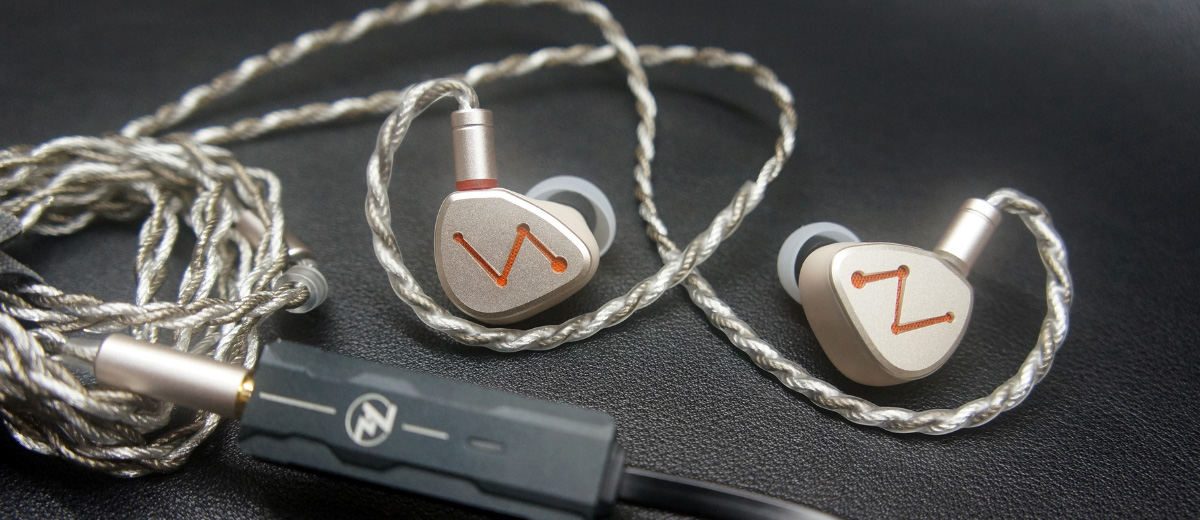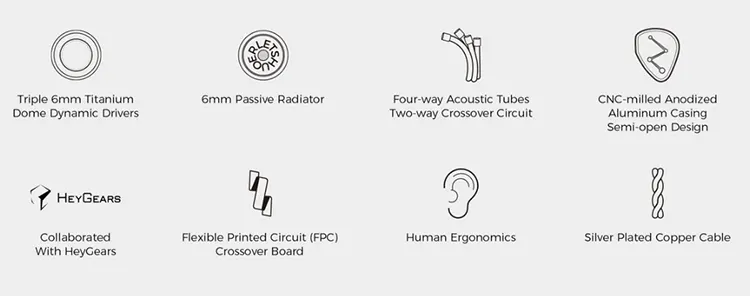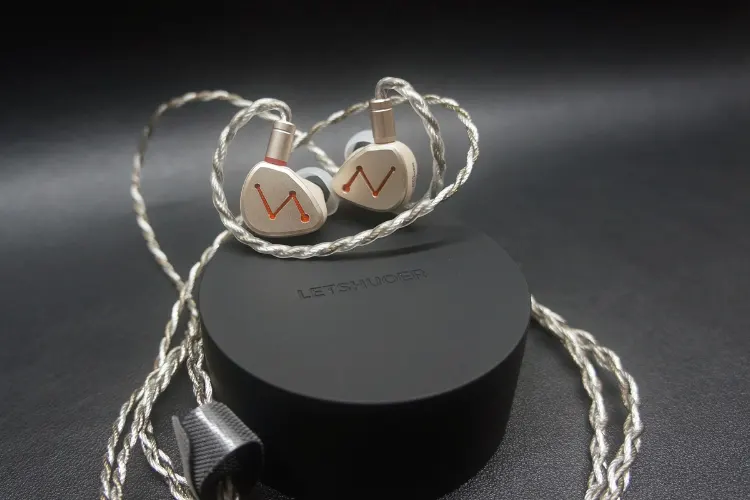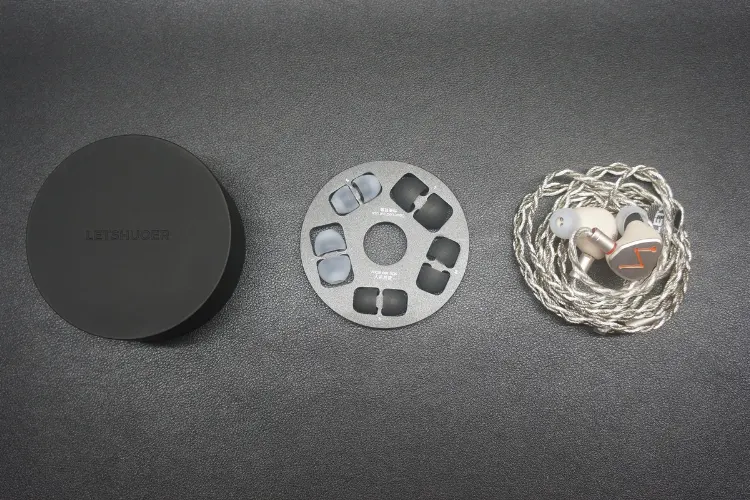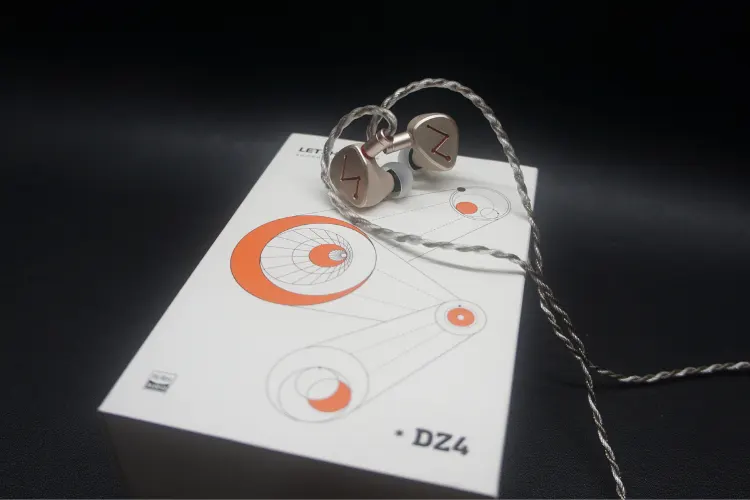We review the LETSHUOER DZ4, which is an entry-level in-ear monitor featuring a unique triple dynamic driver and single passive radiator design. It is priced at $89.
Disclaimer: This sample was sent to us for our honest opinion. Headfonics is an independent website with no affiliate links or status. We thank LETSHUOER for their support
To read more about LETSHUOER products previously tested on Headfonics click here.
Note, that this article follows our latest scoring guidelines which you can read here.
LETSHUOER is best known at the entry level for its class-leading S12 in-ear monitor but has now decided to enter the hyper-competitive sub-$100 market with its latest IEM, the DZ4.
The DZ4’s claim to fame is its use of a 6mm passive radiator in conjunction with its triple 6mm titanium dynamic driver setup, all packed in a sleek beige shell.
Let’s find out if this unique driver configuration has something to offer, or if it’s just the latest fad.
Tech Highlights
The DZ4’s standout feature is its use of a 6mm passive radiator. Audiophiles well-versed in the speaker world are probably used to hearing systems with passive radiators, but this is quite novel in the IEM scene.
The IEM’s triple dynamic driver and single passive radiator are synergized in a unique flexible PCB crossover that splits the signal into low and high-frequency bands. This, in theory, ensures that all drivers work alongside each other instead of against each other.
Aside from the crossover board, the DZ4 also makes use of 4 separated acoustic tubes, one for each driver, acting as a physical crossover.
Design
The DZ4 has a 3D-printed semi-open beige resin shell developed in collaboration with HeyGears, the same company that worked on the shell of the $319.99 Moondrop Blessing 3. This might explain how the DZ4 was able to implement a physical crossover design similar to the Blessing 3.
The shells themselves have a unique satisfying finish. Most 3D Printed IEM shells have a plastic-like texture, while the DZ4 has a finish that resembles sandstone or rough ceramic. This gives it a durable and smooth surface that not only feels comfortable against the skin but also holds up very well in day-to-day use.
The DZ4 is one of the most low-maintenance IEMs I’ve used since its shell does not show any fingerprints and is extremely resistant to micro scratches.
The faceplate is made of CNC-milled anodized aluminum with a bronze-rose-gold semi-open design that reveals orange grilles. The faceplate has a lightning bolt-like pattern that adds some flair to the otherwise plain look of the IEM.
The color of the faceplate doesn’t perfectly match the color of the resin shell, however, its color compliments the beige shell very well.
It has a slightly angled nozzle with a metal mesh filter to prevent dust and debris from entering the acoustic tubes. The nozzle size is slightly larger than 6mm, which may limit the compatibility with some aftermarket ear tips.
Comfort and Isolation
The DZ4 is a very comfortable IEM, thanks to its ergonomic shape and the use of lightweight materials like resin and aluminum. The IEM fits well in most ears with an average-sized ear concha and does not cause any fatigue or discomfort over long listening sessions.
It isn’t quite as comfortable as the Open Audio Witch Pro; however, its comfort is quite on par with the Kiwi Ears Quartet.
The passive noise isolation of the DZ4 is quite good for a vented design. I occasionally found myself not hearing my coworkers calling out my name.
The DZ4 comes with two types of silicone ear tips in three sizes each: black ones with a wide bore and white ones with a narrow bore.
The black ones provide a better seal and bass response, while the white ones offer more treble clarity and airiness. They attach to the nozzle well, and I did not experience them detaching from the IEM throughout my testing.
Stock Cable
The DZ4 comes with a detachable stock cable that makes use of the standard 0.78mm 2-pin socket and terminates with a single-ended 3.5mm connector on the other end.
This is a durable and flexible design with a braided design that prevents tangling and microphonics. Throughout my daily testing composed of a mixture of desk usage and on-the-go listening, I observed no microphonics whatsoever.
The cable is made of four wires of 216-strands. 2 of the wires are silver in color, while the other 2 have a gun-metal grey color, giving it a unique design that stands out amongst other stock cables in the price range.
It is finished with a standard 3.5mm single-ended plug with metal housing and strain relief. It also has a metal Y-splitter with an orange ring and a metal chin slider that matches the color of the faceplate.
The cable uses 0.78mm dual-pin connectors that are compatible with most IEMs. The connectors have clear markings for left and right and have metal housings with strain reliefs.
Packaging & Accessories
The packaging of the DZ4 is quite simple with a splash of personality. It comes with a standard white box that has a tasteful space-age-inspired illustration of the unit’s 4 driver configuration.
Opening the box shows the IEMs in a foam cutout, and removing the foam cutout shows the case, containing the cable and all included tips.
The case itself is a black hard-plastic cylinder that is too large to be pocketable. It has a screw-on top, making it difficult to open and close the case quickly. The large hard case ensures that all the necessary accessories and the IEMs themselves fit nicely inside.
The accessories include two types of silicone ear tips in three sizes each (black ones with wide-bore “vocal tuning” and white ones with narrow-bore “balanced tuning”), the stock cable, a warranty card, and an instruction manual.
Sound Impressions
Bass
The bass of the DZ4 is tight and punchy, with decent impact when needed. It is not very prominent or dominant, but rather subdued and balanced with the rest of the frequencies.
It does not bleed into the midrange or muddy the sound, but the bass response has a strange quirk of decaying slowly. This makes deep bass notes over-extend their stay, contributing to a sense of unnatural resonance.
The sub-bass is satisfactory, thanks to the passive radiator that enhances the low-end response. It has a decent rumble and texture but may lack some authority and presence for bass-heavy genres.
Its mid-bass is slightly more prominent, with a decent slam and speed, but may sound slightly thin or hollow at times.
Mids
The midrange of the DZ4 is the focal point of its sound signature, with a natural and engaging timbre that brings vocals and instruments to life. It is slightly forward and detailed and can come off harsh.
The lower midrange is neutral and transparent, with no bass bleed or warmth. It renders male vocals and guitars with realism and accuracy but may lack some body or weight for some listeners.
Its upper midrange is more elevated and energetic, with a crisp and clear reproduction of female vocals and strings but may also introduce some sibilance or harshness in some tracks.
Treble
The treble region is where the DZ4 starts to falter, it carries the same cold and analytical tonality but does not have the same resolution as its peers at the price point. Snares and hi-hats tend to sound harsh, but this harshness overpowers the nuances between different percussion instruments.
The treble has the same quirk as the bass wherein certain notes at the extreme high end seem to linger on too long with a prolonged sense of delay, which may have added to the sub-par sense of resolution.
Listening to tracks with a range of cymbals, snares, and bass instruments caused some fatigue over prolonged listening, a potential deal-breaker to listeners with more treble-sensitive hearing.
Imaging
The imaging performance of the DZ4 is quite average for the price range. It was not difficult to isolate individual instruments even in complex jazz arrangements.
Its main drawback is the staging performance. One of the things that immediately stood out to me was how narrow the sound stage was when compared to other IEMs in the price bracket.
With other IEMs in the price range, the stage feels like a sector with 180-degree coverage, but the staging of the DZ4 feels like it only encompasses 90 degrees.
This gives it a more intimate presentation which may be preferable to a few, but for my taste, I almost always preferred IEMs with wider staging performance.
Click on page 2 below for our pairings analysis and selected comparisons.

